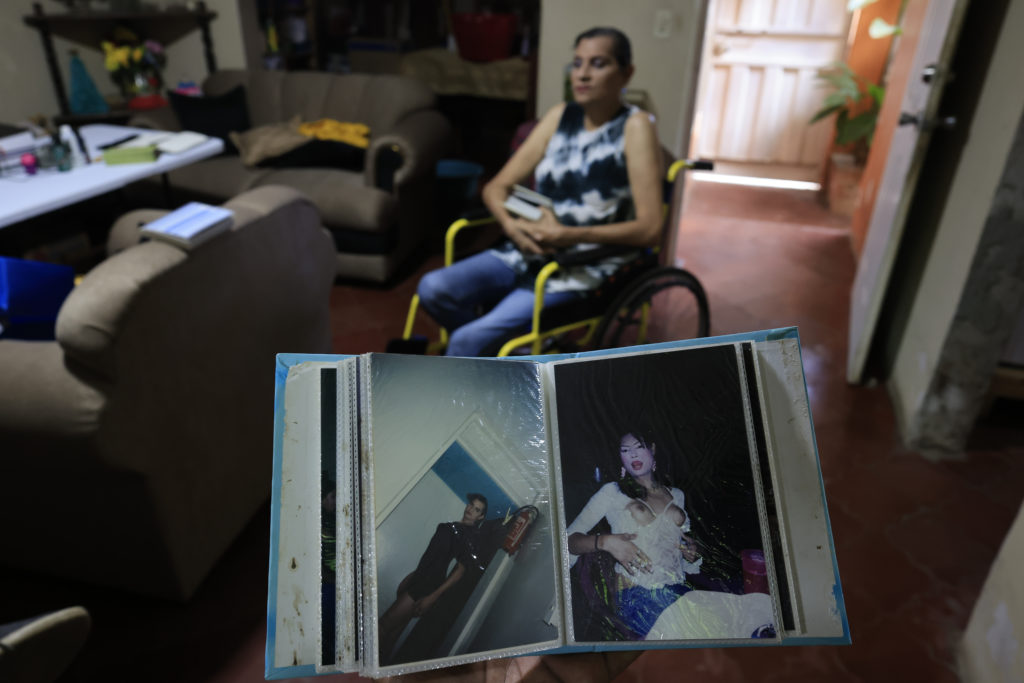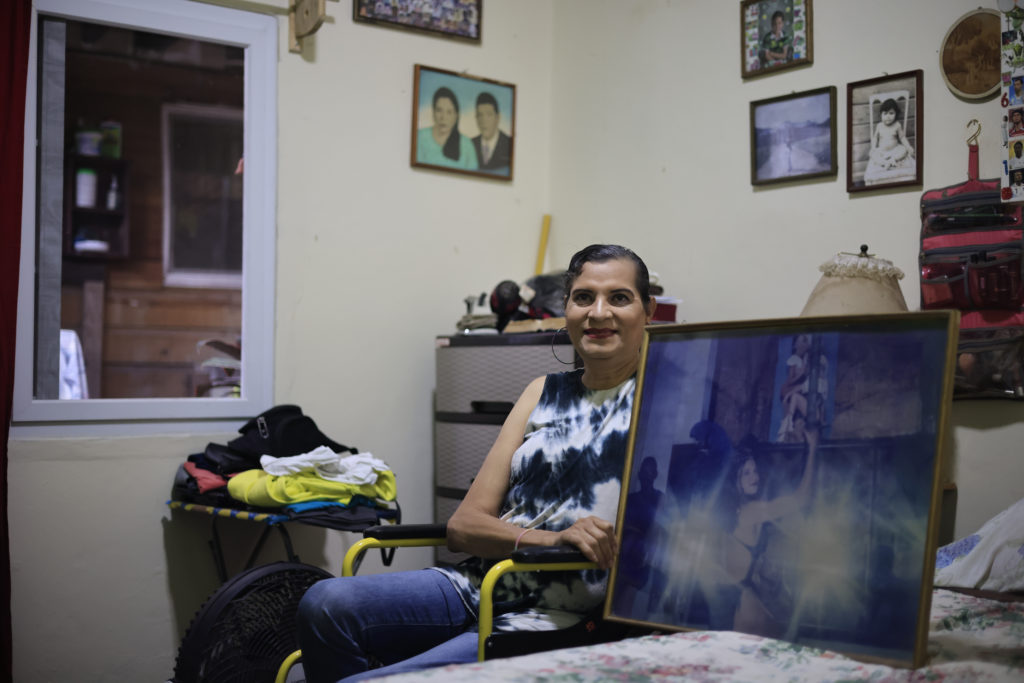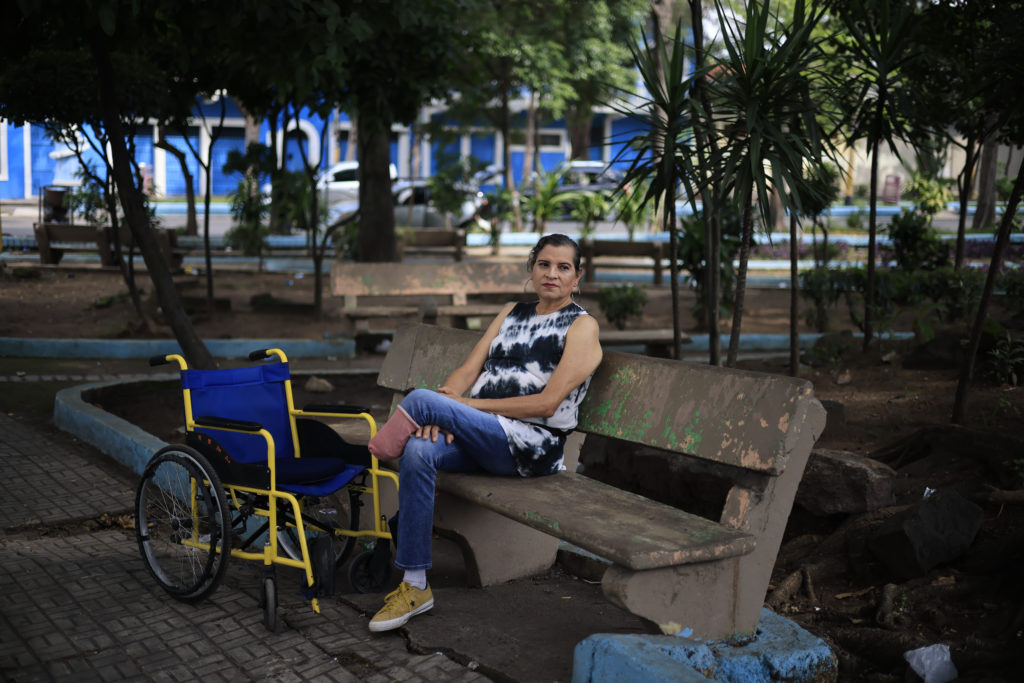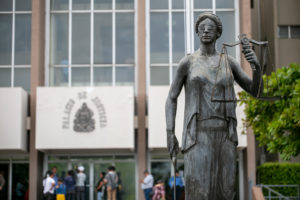Text: Daniel Fonesca
Photography: Jorge Cabrera
Honduras Cuir Archive
The women in the photograph are not smiling at the camera.
In the image captured thirty years ago, four women engaged in sex work wait for clients on a park bench in Comayagüela, under a tree. From left to right pose Gaby Spanik, Bessy Ferrera, Abigaíl Galindo and Michelle: four important figures in the trans movement in Honduras. The night is dense, their gazes piercing.
Flash. A flash of lightning cuts through the night and, suddenly, they are immortal.
In a few years, two of them will be killed.
***
Adorning the walls, arranged in albums, and nestled in portrait cases, initially, they were simply Abigaíl Galindo’s personal photo collection, a hobby capturing her friends over 35 years. Abigaíl, now 52, left sex work 20 years ago, and her photographs have become integral to the collective memory of LGTBIQ+ people in Honduras.
They are digitized for Instagram, printed in poster size, thousands of people have seen them. From the Abigaíl who walked the streets of the capital of Honduras with heels, sequins and fury, there remains a slim, almost shy figure, who moves slowly in her wheelchair, with one leg less, and who is still surprised when she finds hundreds of people gathered around her, listening to her.
For most of her life, photography was no more than an amateur hobby for her. She did not expect, nor would she have dreamed, that her photos would be part of exhibitions or that she would guide tours through the fragments of her memory. Her intention was to capture moments on 60-millimeter film, to remember her friends, the parties she went to, her loves and nights, once they were old.
“I always liked taking pictures,” he says. I used to carry a roll of 36 film. When we went to an event or went out, the first thing I would grab was the camera, ready to take pictures of my companions, my friends.
In June 2022 Abigaíl met a photographer named Dany Barrientos. He told her about “historical memory” and a project to “reconstruct and deconstruct” the history of people like her: the Honduras Cuir Archive, an initiative that sought, through any piece of paper they could find, to prove that LGTBIQ+ people existed and exist. Abigaíl, with her photos and her stories, was going to become a crucial piece of the living memory of those who remained and those who are no longer here.
“I took so many photos to record my memories,” she says. Photographs are very important because they are the story reflected on paper. If we have a memory this helps remember everything, we can explain it, but without a photograph… No story can be told without proof, right?

But the stories behind Abigaíl’s images also reveal what various LGTBIQ+ organizations in Honduras have called a “transgenocide,” of which she is a survivor. The rest of her friends, like the ones posing in the photo in the park, met similar fates: one night two men got into a car with darkened windows and drove through the city with death in hand. Bessy was shot to death. Her body was left lying on the sidewalk where she worked.
One day a client told Michelle: I’ll take you with me to Guatemala, and she said to us: I’m going to Guatemala with a client. What happened in between is not known, what is known is that they were able to identify what was left of Michelle by her tattoos. Abigaíl gets a shiver when she remembers.
-Only two of us are alive, Campero (Gaby Spanik), who is in Germany, and I, who still live here.
Here: Honduras. According to the international organization TransRespect, in this little piece of land between the Caribbean and the Pacific, more trans people are killed per million inhabitants than anywhere else in the world; within this violence, sex workers have taken the lion’s share. Different organizations have dedicated themselves to register the attacks, the murder weapons, the court rulings and whatever is needed to explain the complexity of all this death, but the conclusion is that in Honduras, trans women have average lifespan of 35 years, and do not live to be old.
– I always tell the girls, “Let’s take a picture, because we don’t know if it’ll be the last one.”
***
I asked Dany Barrientos, the founder of Archivo Honduras Cuir, what he sees when he looks at the 700 photos of Abigaíl Galindo; he answers without hesitation.
-The genealogy of the community.
Dany Barrientos studied contemporary art at La Fototeca in Guatemala and has a background in documentary and editorial photography. He was inspired by projects in other countries, such as the Archivo de Memoria Trans in Argentina, to tell “the other story”: the memory of the LGTBIQ+ population.
In the first months of the project’s life, he heard from a former trans sex worker who had recorded much of the 1980s and 1990s. Not many years after the last military dictatorship in Honduras, when the nights were longer, the police controlled the streets and the first LGTBIQ+ collectives were founded in the country.
Abigaíl says the Archive saved her life. After an accident with boiling water, she was left with serious burns on her left foot and, due to complications from her diabetes, she lost her leg below the knee. Death, from which she had escaped so many times, was coming for her, so she sat down to wait for it. The only thing she was going to leave were her photos, and here comes someone promising to take care of them.
The Archive, which stores all documents related to the diverse population in Honduras between 1934 and 2015, does not have a physical space. In the beginning of the project, the photographs and documents that had been recovered were digitized and uploaded to Instagram, including contextual information like everyday scenes, parties, love letters, newspaper clippings, etc.

Hundreds of people from the LGTBIQ+ community in Honduras began, for the first time, to see their story reflected. Months after the inauguration of the Instagram account, several live conversations began where the story behind each photo and the lives behind each name were narrated.
Grecia O’hara, trans activist and defender of LGTBIQ+ rights, highlights the importance of the Honduras Cuir Archive for the country’s diverse community. It allows us to remember the lives, struggles and work that past generations have done to advance the recognition and respect for human rights in Honduras, she says. While also pointing out that the project helps build a national LGTBIQ+ identity.
“Whenever we think about LGBT rights here, we are always consuming the international: the U.S., the Mexican, the southern part of the continent,” says Grecia. Here we also have a history of our own. Let’s highlight our own Honduran people, our people who we recognize as leaders so that, as a community, we can see ourselves reflected in them and within our country-specific context.
It is because of this constructed Honduran LGTBIQ+ identity that Dany Barrientos highlights the photographic work of Abigaíl Galindo. Her collection of photos, he says, reveals the fluidity of her gaze, fluency with a camera and a drive to portray the things she loved and that made up her world.
“I like how it juxtaposes the look that the large consortiums of journalists such as La Tribuna or El Heraldo, who also portrayed her, had. And the way she looks at herself,” says Dany, who explains that many of the more intimate photos, such as those she took of her family or lovers, are not part of the Honduras Cuir Archive, but represent a part of the photographic body that, perhaps, allow us to better understand the figure of Abigaíl Galindo beyond her role as a representative of the LGTBIQ+ population, trans activist, showgirl or sex worker.
“Lately I have a lot of affection for a section of Abigaíl’s archives that are photos of her family. In those images there is a nostalgia, a very nice melancholy, I can’t help but wonder the contrasts between Abigaíl’s identity and that of her mother – whether it serves as a burden, a form of rebellion, or aspects of her mother’s persona that she has embraced for herself.”



Abigaíl’s house, situated in an old neighborhood of Tegucigalpa, is a museum, a souvenir store, and a mixed-match of things. From the damp walls hang faded paintings and hundreds of handicrafts. Paper, plastic and rubber flowers. A dream catcher with colorful feathers and a portrait of his mother. On the shelves are photos of her family, scented candles that have never been used and half-burned kerosene candles. There are porcelain figurines and a pile of eagles, the symbol of Motagua, the soccer team of which she is a fan. Next to it, placed with great care is her companion: a Canon Sure Shot 38-60 mm.
Abigaíl grew up with five older siblings and one younger brother. She is the daughter of José del Carmen Galindo, an Air Force soldier, and Eva Soto, a seamstress to whom Abigaíl dedicated a considerable part of her work. The portraits of the mother made by the youngest of her daughters emphasize the naturalness of home life, in contrast to the rest of her work, where artifice and excess are the charm.
I would stand in one place and my mom would be distracted, and I would say “Mommy!” and she would turn to look and flash, and I would take the picture. Distracted, she would grab it. I liked it because she took them like that, without posing.
Eva was an old-fashioned woman: serious, homely, living under the authoritative influence of her husband, and a dreamer. She had made it to the sixth grade and tried to continue studying, but one day her husband set her notebooks on fire.
Her mother’s personality and experiences, plus years working in the streets of Comayagüela – Tegucigalpa’s sister city, precarious and with high rates of violence – molded Abigaíl from a withdrawn and even stunned child into a rebellious, volcanic woman with a sour sense of humor.
“At first they didn’t accept me… as usual, right? she says. In every family the news always comes like a bucket of cold water. I say that many times it’s not that our parents don’t like us… what they want to avoid is society’s rejection of us. I remember my dad once told me “I’d rather have a thief, a murderer or a pothead than have a fag in the house”.

Her father did not find out for several years and her mother, who learned about her daughter’s identity through gossip, did her best to hide it. To no avail. At the age of 16, Abigaíl would sneak out of her house with a backpack over her shoulder, wearing a dress and hidden heels, and meet her friends, several years older, who were involved in sex work.
“The first time I went out just to see what it was like, to accompany the girls on the street, to get to know the atmosphere. We would go to the “chupaderos”. I have always been tall; we used to put on make-up as if we were a little older and they let us in. Then the other girls gave me a wig and I looked at myself in the mirror and felt good. I saw myself reflected, who was not who I was in my house.”
***
Three circles of light, camera flashes or reflector lights, bounce off a mirror behind her. In the early 1990s photo she is standing on stage in a blue and black bikini with a feather headdress on. She balances on a tube, smiling. Behind her, well hidden in the shadows, a security guard stands, arms crossed and with an I’ll break your face expression: his job was to prevent drunk customers from touching Abigaíl on her show nights. The image decorates her room, accompanied by memories of her best years.
“That guy over there was in love with my bonyness,” she says, “but I didn’t even consider the possibility of a relationship. “We can’t have a romantic relationship here,” I told him. It would have been dangerous.
Not that the danger was ever lacking, but neither was the love. One of her albums is dedicated exclusively to her 23 husbands who survive frozen in time, their gaze cloudy with lust. They lie carefree and naked, smiling at the camera, helpless. 22 of them are dead.
The photos of her show nights are all the stuff of a legend. For years Abigaíl dominated the bars and discos “de ambiente” in Comayagüela and Tegucigalpa, where she would become Selena or Thalía for a few minutes in exchange for food and all you could drink. Despite being a 16-year-old trans teenager, she was already a night star. She earned more from her clients on the street, but her passion was the stage.
In one of her photographic collections dedicated to that era, she is seen at parties and shows, walking the catwalks in beauty pageants, parading through the streets in a palillona dress or in a feathered one during one of her shows.
“I’m not going to say that everything was dark, gray and black. There have also been beautiful moments.”
In those moments, scattered in the immovable time of the small blue box where she keeps her photos, someone appears smiling. A Halloween costume. Military clothes. A naked man. His mother’s face. Colored balloons. A lit cigarette. A corset. A little dog in a handbag. A lover. A beauty queen with her tiara. A woman dressed as a man. A Catholic baptism. Two men kissing. An impossibly blonde wig. A heart-shaped cushion. His mother’s face. A chubby pink baby. A thigh with a heart tattoo. A rainbow flag. A pair of breasts. A shirt that says “Next door is gay.” Six women dressed as men. A poster of Pamela Anderson naked. A parade of popcorn poppers. A leopard bra. A person dancing. A person who died of AIDS. A person who was killed. A person who fled the country. Someone laughing. Another lover. The face of his mother.

There are no photos of the clients.
Abigaíl says that she began sex work at the age of 17. In thirteen years she had offered her services to all kinds of men. Professionals, diplomats, politicians… They wanted to see her dance while they masturbated, talk about their problems without being judged, sleep with someone of the same sex. There were also those who came with requests that, after many years later, still disgust her.
And policemen, the military.
Encountering them meant good pay or a night in a dungeon. At the end of the 1990s, says Abigaíl, the mayor of Tegucigalpa, Vilma Castellanos, ordered sex workers to be removed from the Hotel Honduras Maya area, the most elegant hotel at the time and where clients paid the most. During this time she was arrested 25 times, accused of scandal on public streets.
“We were running up and down like deer because they wouldn’t let us work,” she says, “and the patrols would arrive all the time. Once they took me to the Ulloa post in a civilian paila. Me and eight others. The policemen were also in civilian clothes, but armed to the teeth. They took us by force, they kidnapped us. They took us through Ciudad del Angel. It was all dirt. It was dark, dark, and they told us: “Here we are going to kill all these assholes” Abigaíl’s voice narrows to a single, monochord thread, the words slipping through her teeth-. We all hugged each other -she continues-, we began to cry and say goodbye. And the policemen started to laugh. We thought no way, that all that was left was to hold hands so that when we were dead we could leave together. But they started shooting in the air. And then what did they do? They put us in the car again and took us to the post, where they raped us. While they were raping us, they told us that they were going to kill us, that we were assholes, that we were worthless. That people were not even going to cry for us.”
She has no pictures of any of it, but she doesn’t forget.
***
-If the photos were not there, how would you explain who Abigaíl Galindo is?
“I would say that she is an amazing human being with great resilience,” says Dany Barrientos, “with a burning fury inside that can consume everything… and also an incredible generosity.”
***
Abigaíl thinks about how she wants to be remembered. She thinks about it because her friends are usually remembered for their death. She wants to be remembered for the totality of her life, for the art she created, for the portraits of her loves and also for those last photos she took of her friends and companions, before they became statistics and lived only in her photographs and in her memory.
Although she is not as dedicated to photography as she used to be, Abigaíl Galindo has begun to explore new interests: she’s writing a memoir, guides a tour of the Archive, acts in short films and began attending a Latter-day Saint church, where she found a new mission: to change 200 years of Mormon tradition.
The bishop says to me: “I don’t know how to treat you”. Here on earth anything goes, I respond, so you are going to call me Abigail because that is how I feel good. Don’t call me anything else, unless you are going to give me a check with money. Then yes, put my legal name there.






